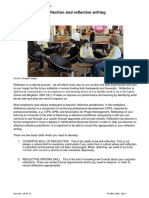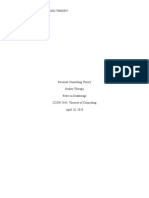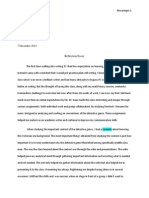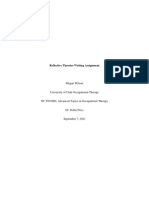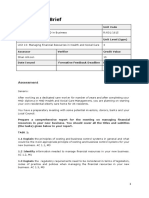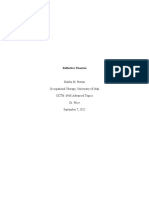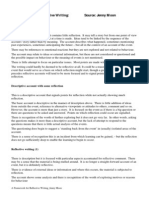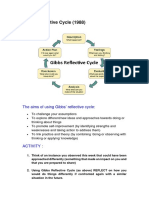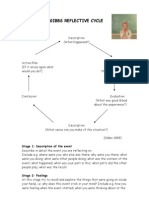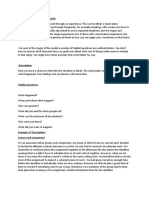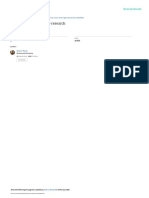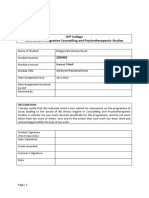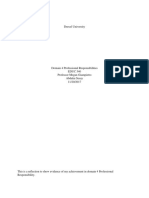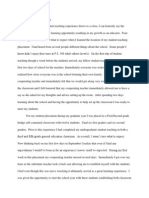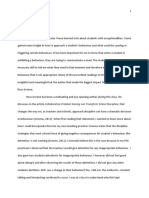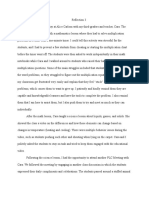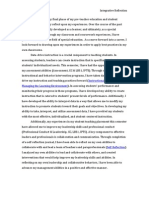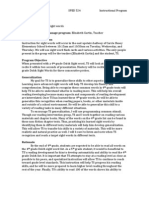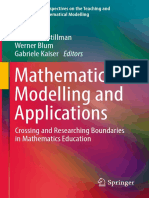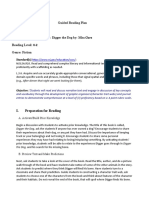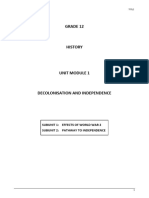Self Reflection Assignment
Uploaded by
ecurtin1Self Reflection Assignment
Uploaded by
ecurtin1Elizabeth Curtin
SPED 426
Self-Reflection Project
Journal One: February 11, 2013 Today, we were shifting lesson topics in my co-taught writing class. Last week, the class was focusing on narrative writing, and today we were making a shift into research writing. In order to effectively implement this topic in the classroom, it was necessary for me to collaborate with the general education co-teacher. We needed to decide exactly what topics to cover for the research unit, how we were going to instruct lessons (what model), and how we would assess all students effectively. There are three students with disabilities in the classroom, so I felt it was necessary to also collaborate about how we would differentiate instruction (through the process, product, or content) to meet these students individual needs. In order to begin collaborating, I asked the general education teacher to meet during our lunch/plan time. We met today during lunch to begin discussing our future plans for the co-taught writing class. We spent the entire lunch period in discussion and decided to implement a parallel teaching model. We would split the class into two halves, and the students with disabilities would be in my group. We would then teach the same content to our individual groups, and I would provide some differentiation to the students with disabilities. We also determined that we wanted students to be knowledgeable about components of research (citing, taking notes, thesis statements, etc.), be able to write a research paper, and create a presentation. I believe that I was effective in initiating collaboration with the general education teacher in this situation. I had approached the teacher and suggested that we find a common plan time to meet and discuss the upcoming unit. Additionally, we were able to determine many general factors for the lessons and instruction in this unit. This helped us to determine roles and set shared goals. Yet, I still feel like we would benefit from more collaboration. I believe that it would have been effective to talk with one another about common plan time for lesson planning so we were ensuring that all students were receiving instruction on the same topics (as is done in parallel teaching). While I felt comfortable asking the teacher to meet once to set goals for the unit, I was nervous to discuss a consistent plan time with this teacher. As a new teacher, I felt slightly intrusive and failed to leave the meeting
Elizabeth Curtin
SPED 426
Self-Reflection Project
with expectations for co-planning throughout the unit. I feel as though common and consistent planning is imperative to successful teaching and wish I had made this clearer in this initial meeting. Journal 2: February 12th, 2013 Each day, one of my paraprofessionals teaches a tier 3 spelling group with four students with disabilities. I had noticed that the paraprofessional was not implementing the lessons as directed by my cooperating teacher. For example, she was not fully following the spelling rules as laid out in the lesson plans. This can be detrimental to the students because they are not receiving the intended instruction they need. In response, I mentioned this concern to my cooperating teacher today. Through discussion, we determined that this was not happening purposefully from the paraprofessional, but rather there was a lack of understanding of the spelling rules. The paraprofessional did not necessarily catch-on to these spelling rules, and therefore was not able to correctly and successfully implement lessons for students. In response, my cooperating teacher and I collaborated to create a new schedule. We wanted to put my cooperating teacher or myself in with these students for spelling and use the paraprofessional as push-in support for other students. Therefore, my cooperating teacher and I met after school to determine the most appropriate placement for all teaching adults. Through discussion of each persons strengths and weaknesses, we were able to determine the most appropriate placement for all adults at this time. We decided that my cooperating teacher would take over the spelling group, and I would take the place of my cooperating teacher in another general education co-taught setting. The paraprofessional would be placed as push-in support with other students instead. After this discussion, we informed the paraprofessional of the new schedule to ensure all three of us were on the same page. I feel as though this collaboration was extremely effective. I felt very comfortable bringing up this concern with my cooperating teacher, and she seemed to value and respect my opinion. We were able to work together effectively to more
Elizabeth Curtin
SPED 426
Self-Reflection Project
successfully place each teaching adult based on her own individual strengths and weaknesses. We each listened to each others opinions and observations of different situations in a positive and equalized manner, and we were able to then shift the schedule to meet all students needs. Finally, we were able to meet collectively with the paraprofessional to communicate the new expectations and schedule. Overall, this effective collaboration will hopefully lead to more appropriate placement for all teachers and aides. Journal 3: February 13th, 2013 Today, I had been noticing that one of my students has been acting strangely lately. This student gets sensory breaks built into her schedule, but recently she has needed more and more breaks to focus. Additionally, the student has been exhibiting strange behaviors including what seems like hallucinations. This was concerning to me because the students progress behaviorally seems to be regressing. This can be detrimental to her education because she is being pulled out of her groups and classroom often to go to the sensory room. In response to my concern, I approached this students general education teacher. I wanted to speak with the teacher to develop a better understanding of how the student acts when I am not in the classroom and to also see if the teacher has similar concerns. After speaking with the teacher, I determine that she also has been noticing behavioral changes with the student. We decided to meet after school in order to develop a plan of action. After school, I met with the general education teacher. We were able to collaborate effectively to determine what interventions we can put into place to help the student. We decided to start using the zones of regulation to help the student self-monitor her behavior and need for sensory breaks. The general education teacher and I created a self-monitoring sheet that we agreed would work both inside and outside of the classroom. We also determined different times in which we would be responsible for completing the sheet with the student. We split other jobs that came along with this new intervention (informing the aides, emailing the students parent, telling my cooperating teacher, providing information to the
Elizabeth Curtin
SPED 426
Self-Reflection Project
parents, etc.), as well. Being able to share responsibility and ownership over this new system, I hope, will help us effectively implement it. It was nice to be able to communicate and collaborate with another teacher who spends much time with this student. It helped give both of us a more through understanding of the students needs, and allowed us to develop a plan of action successfully. Journal 4: February 15th, 2013 Each day, I teach two fifth grade students in a pullout group for spelling, math, and intervention. During the intervention block, an aide helps me teach the students. Over the past few weeks, the aide and I have been separating into two oneon-one groups during this time. This allows us to better meet each students needs because each student is reading at a very different level. I have been doing the planning for both groups for this intervention block, though. I complete a reading folder for the other group that includes that weeks lessons and materials. This week, the other groups (with the aide) finished the materials early on Wednesday. Thus, on Thursday, there was no lesson or materials for this group to do. This situation was detrimental to the students learning because I was forced to come up with a plan very quickly. The materials were not prepared and the lesson was not as complete or planned as it could have been. In this situation, I believe that both the aide and I were not collaborating effectively. It would have been helpful for the aide to communicate with me about the lack of materials for the next day. If the aide told me that the student had finished early, I would have been able to better prepare. On the other hand, I am also at fault for not consistently initiating communication with the aide to ensure I, as the teacher, was aware of what was happening with each of my students. In retrospect, I wish I would have spoken with the aide at the end of each day to make sure the next days lesson was going to be effective and prepared. I believe that there was a lack of collaboration between two teachers and this led to a breakdown in the daily plan. I am now more aware of my role as this groups leader, and will be sure to talk with the aide daily to touch-base. I believe that this kind of consistent collaboration will help to not only ensure that lessons are planned, but it will give me an idea of the
Elizabeth Curtin
SPED 426
Self-Reflection Project
students learning progress. This will also help me to write effective and successful lesson that cater to the students progress. Journal 5: February 18th, 2013 Over the past few weeks, one of the teacher aides that works with one of my students has been pulling the student 15 minutes early from our last group to take her to the bus. She is pulling this student out way earlier than needed to go get her things ready for dismissal. This is detrimental to the student because she is getting pulled 15 minutes early from our writing small group. The other students in the group are able to finish the lesson and work, but this specific student is unable to complete her work and she is behind. In response to this, my cooperating teacher has approached the aide in the past to tell her to make sure the student stays for the whole group. While the aide agrees, she is not following the directions on a daily basis. Early this week, the students were doing an activity and I personally asked the aide to allow her student to finish the activity before she took her to get her things. Yet, the aide ignored my request and chose to pull the student out early anyways. This was quite upsetting for me, and I was frustrated that the student wasnt able to complete the rest of the lesson with her peers. While my cooperating teacher and I have both approached the aide about this situation, I am slightly intimidated to continue to push for this student. As a new teacher to this school, I dont want to make anyone feel like I am stepping on their toes or trying to overstep my boundaries. I approached the aide with a question rather than a more direct request. I believe it might have been more effective if I told the aide politely that I wanted the student to remain in the group (especially since my cooperating teacher has already approached her once). As well, I am feeling nervous about the upcoming days. I am reluctant to approach the aide again, but know this is necessary for my students education. While I dont feel as though I communicated most effectively to this aide today, I am hoping to continue to communicate and collaborate with the aide in a way that ensures the best education for this particular student.
Elizabeth Curtin
SPED 426
Self-Reflection Project
Behavior One Managing timing of collaborative activities to facilitate mutual decisionmaking at each stage of collaborative process. I believe that this is an area of weakness for me when it comes to planning and collaborating with others. Specifically when co-teaching, it is imperative to plan and time collaborative activities in order to effectively plan and implement lessons. Setting aside specific time each day or week to meet with another team member ensures that each collaboration partner is involved, informed, and has ownership of decisions. In effective collaboration teams, it is not enough to have informal collaboration taking place when it is convenient each day or week. Rather, ensuring that collaboration is consistent and through is the first step in creating successful instruction and making the best decisions. In my own collaborative activities, I have difficulty managing specific times to collaborate with my team members. I am usually comfortable asking a team member to meet once or twice about a specific subject or issue, but I have not had experience in approaching someone to find a common meeting time. When thinking about approaching a more experienced teacher to manage our collaboration time, I feel slightly intimidated and anxious. I do not want to be a burden on my collaboration partner, even though I know this is a necessary step in the collaborative process. As well, finding a common plan and collaboration time that is consistent and convenient for both myself and those I collaborate with can be a seemingly daunting task. I believe that being a new and temporary teacher to the school makes me less comfortable approaching other teachers with my thoughts, ideas, and needs. While this process is intimidating, it is absolutely imperative that my coteacher and I find a common plan time. We co-teach a fifth grade writing class, and we need to work together to plan, implement, and reflect on our instruction. Thus, finding a time each week for us to lesson plan and a short time each day for reflection would be extremely beneficial in my co-teaching setting. As well, as a student teacher, it is important that I set aside specific time to meet and collaborate
Elizabeth Curtin
SPED 426
Self-Reflection Project
with my cooperating teacher. Discussing various instructional decisions and ideas with my cooperative teacher will ensure that I am developing professionally and providing adequate instruction for my students. Learning to approach collaboration partners and communicate my ideas and instruction at a consistent and set time each day or week will be beneficial for both my students and my professional self. Finding a shared solution with others that I work with will help create communication, teamwork, and positive outcomes, and I must be willing to step outside of my comfort zone to do so. Examining myself more deeply and challenging myself in uncomfortable situations will help me develop in this area overall. Behavior Two Pursue issues with appropriate persistence once they arise in the collaborative process In the collaborative process, it is possible that the same issues arise consistently. This can happen with those you are effectively collaborating with, but it can also occur with someone who is resistant to collaboration. When a collaborative partner is resistant to collaboration, it can make implementing a problem solving process extremely difficult. It is imperative to consistently and appropriately advocate for students needs regardless of issues within the collaborative process. Students education and learning depend greatly on teacher effectiveness, so it is extremely important to find manners in which to solve issues that arise. With persistence, as the behavior above indicates, collaborative partners can work together to overcome obstacles. In my current setting, I consistently deal with paraprofessionals that seem resistant to collaboration. This can create daily problems for myself, and can greatly impact students learning. In one situation described above, a paraprofessional was not responsive to two separate interactions. The paraprofessional seems to resist direction or suggestion from myself and my cooperating teacher, and the student is suffering as a result. Additionally, the teacher I co-teach with has a relaxed collaborative attitude. He prefers to split the work rather than work together to form solutions. Thus far, I have not been very persistent in these issues. While I feel
Elizabeth Curtin
SPED 426
Self-Reflection Project
as though I am a respectful and professional person, I am a non-confrontational person. I prefer to go with the flow and tend to be a follower rather than a leader in these types of situations. As a new teacher, I observe myself exhibiting this attitude even more often. I am less comfortable in this setting because there are many veteran teachers and paraprofessionals that I am working with. I do not want to offend those that I work with so I tend to not pursue many of the issues independently. Through working on being more persistent in collaborative issues, I believe I will benefit not only my students but also myself. I want to communicate with and work together with my collaborative partners to problem solve the many issues that arise on a daily basis. I want to share equal ownership over decisions and planning and feel as though we are a team. Having shared responsibility over the collaboration process and decisions will help to ensure all team members feel valued and important. Through persistent pursuance of issues, I will be able to best collaborate and provide instruction to all students. Baseline Behavior 1 (Managing timing of collaborative activities) February 20th, 2013 Next week, we are testing students on the ISAT all week. This can greatly affect my instruction to my students because many of my groups are not going to take place due to testing. Additionally, my cooperating teacher and I are going to test many of our students using the IAA, and we will provide accommodations to all of our other students. Thus, my cooperating teacher and I needed to collaborate to schedule these testing times and our instructional time for the next week. We both knew this scheduling would take a lot of time to do, and we also needed to meet with the other special education teacher to ensure all students needs were being met. In this situation, I acted as more of a follower than leader or decision maker. As a new teacher, I do not have much experience with standardized testing or scheduling for ISATS. Thus, I just listened to what my cooperating teacher and other special education teacher wanted to do. I met with them when they told me to, and
Elizabeth Curtin
SPED 426
Self-Reflection Project
did not provide much input or insight. I was able to point out a few flaws in the schedule, though. This was helpful to the team, but I was more of a bystander in this collaborative situation. I allowed them to place me where I was needed most, and found it more helpful to learn from this situation through observation. I might have been able to provide more insight if I had felt more experienced or comfortable in this situation, but instead I chose to observe and listen. Thus, I still know what is going to be happening next week, but this collaboration might have gone more quickly and smoothly with my additional voice. February 21th, 2013 This week, we have been preparing for ISAT testing next week. In my cotaught writing class, the general education teacher wanted to focus on practicing for extended responses for next weeks testing. He wanted to focus the week on practicing for the ISATs, and he told me he had some extended response examples that he wanted to use. Thus, I have been going to the class to teach, but the general education teacher has prepared all lesson materials. I did obtain the materials the day before the lesson so that I could accommodate for the students with disabilities, but I did not participate specifically in lesson planning. As the co-teacher, I just went to the class to assist students in writing extended responses and modified the work for the students with disabilities. In this situation, I believe these lessons could have been more effective if I had met with the co-teacher to plan them. I did not approach the general education teacher to ask for a shared plan time. If I had, I believe that I could have provided insight into the lessons to make them more engaging and effective. Rather, I chose to just go with the flow of what the general education teacher wanted. I did not exert my opinion in a way that would best benefit all students. While I was still able to accommodate the lesson for my own students, I believe the lessons could have been more effective overall if the general education teacher and I had planned together from the start. Finding a shared collaboration time will help the general education teacher and I create positive and successful lessons in the future.
Elizabeth Curtin
SPED 426
Self-Reflection Project
February 25th, 2013 Today, my cooperating teacher and I once again had to review the schedule for the upcoming ISAT week. We needed to look over the IAA assessment books as well as the other tests in order to provide accommodations appropriately. It was necessary that I review these documents with my cooperating teacher so she would be able to answer the questions that I had about test administration and proctoring. I needed to be fully aware of the different components of the test and how to properly provide accommodations to my students. This required much review of testing materials, including both the IAA and ISAT. After the students left on Friday, my cooperating teacher and I sat down together to go over the test. My cooperating teacher had to leave for a meeting at 3:00pm, so this only left us with 30 minutes of time to look over materials together. I felt somewhat rushed when reviewing materials, and am now going to go in early on Monday to continue reviewing to ensure I am fully prepared. In this situation, I believe I could have been a more effective collaboration partner. Waiting until 2:30pm on Friday afternoon to review the ISAT and IAA tests did not leave nearly enough time for my cooperating teacher and I to discuss the tests, schedule, and administration for next week. Instead of realizing the importance of setting aside time to look over these materials, I waited until the last minute. This was ineffective because I was unable to have all of my questions answered, and my cooperating teacher and I now have to meet again on Monday morning. As a team member, I should have approached my cooperating teacher earlier in the week to find a collaborative meeting time. Managing the collaboration time more effectively would have led to more through and successful results. In the future, I should recognize upcoming events (such as ISAT, etc.) and ensure that I manage the collaboration time effectively to promote positive outcomes. Baseline for behavior 2 (pursue issues with appropriate persistence) February 22nd, 2013 With upcoming ISATs, my cooperating teacher and I have been working closely with the school administration to ensure all of the students with special
Elizabeth Curtin
SPED 426
Self-Reflection Project
needs have a proper testing location, accommodations, and schedule. This is an extremely difficult process because of the diverse needs of many students. Last week, the principal provided my cooperating teacher and I a tentative schedule. The administration had placed me in a 4th grade classroom as a proctor for almost all of testing hours. This is an issue because my cooperating teacher wanted to use me as a proctor and extra helping hand for our own students. Many of our students need to be testing individually and also need to take many breaks. We had planned to use me as a person to help students focus and take breaks when needed (rather than placing a substitute who was unfamiliar with the students in the room with them). Thus, my cooperating teacher and I met with the principal to discuss our concerns. The principal was not very receptive to our needs, and he informed us that I would be needed more with the larger group of 4th grade students. Even though my cooperating teacher and I expressed our concern with putting an unfamiliar substitute with my students, the administration was not response or helpful. After meeting with the administration, my cooperating teacher chose to remake the schedule anyways. She placed me with our own students and put a substitute with the 4th grade class. She did this against the approval of administration in an effort to best advocate for our students. I chose not to pursue this issue further, and rather listened to what my cooperating teacher was telling me. I believe this situation could be solved more effectively if my cooperating teacher and I were more persistent with voicing our concerns. We could set up an additional meeting with the assistant principal or other administrative member. I believe this could help alleviate this situation and provide a solution that all people involved are comfortable with. Rather, though, I am unsure of how I will be used during testing and feel uncomfortable with the lack of communication between my cooperating teacher, the school administration, and myself. February 27th, 2013 Within the next few months, almost all of my students are going to be having an IEP meeting. Thus, my cooperating teacher and I have been working on collecting data on my students goals and objectives. We have been preforming many different
Elizabeth Curtin
SPED 426
Self-Reflection Project
assessments to determine students abilities in various subjects and tasks. Today, I asked one of the paraprofessionals to give one of my students a multiplication assessment. During the assessment, I overheard the paraprofessional scaffolding the students answers greatly. After receiving the assessment back, it seemed as though the student scored much higher than her actual skill level, and I suspected that the paraprofessional had led the student toward many of her answers. I preformed the assessment with the student, and the student did preform at a much lower level. I approached the paraprofessional once today to asked if she had provided the student with any answers, but she said she had not. In this situation, I believe I should have been more persistent in finding out what happened during the initial assessment. It is imperative that I collaborate with the paraprofessionals in my classroom. This means clearly communicating expectations, needs, and instructions at all times. It is also important that I fully understand their actions with students so I can help them best provide instruction to all students. In this situation, I could have been more persistent in finding our why the paraprofessional did not preform the assessment properly with the student. This was most likely a lack of communication between myself and the paraprofessional in the way in which to properly preform the assessment, but I chose not to push the issue further in fear of confrontation. It would have been more effective if I had voiced my concern respectfully to the paraprofessional so I could better understand the situation. This would also ensure that the paraprofessional and I could effectively collaborative in order to determine the different ways to preform various instructional tasks with all students. Rather, though, I redid the assessment to gain a more clear result. While I was still able to obtain the results I needed, I did so without proper and most effective collaborative practices. February 28th, 2013 In my co-taught writing class, there are many times in which behavior management can become an issue. The students in this class have many diverse needs, and many of the students act out behaviorally on a daily basis. In response, I have implemented a managing the learning environment program in this classroom.
Elizabeth Curtin
SPED 426
Self-Reflection Project
I have implemented a rewards-based system in which students can earn incentives for good behavior. Before implementing this program, I met with the general education teacher in order to collaborate and decide on consistent expectations and punishments in the classroom. After determining these expectations and responses, I noticed that the general education teacher and I did not seem to be consistent in our behavioral expectations. Last week, I approached the general education teacher during lunch to have a short conversation about the programs success in the classroom. I expressed my concerns that I thought we might be confusing students by not following the same classroom expectations and responses. We had a short collaborative session to reevaluate our classroom practices in an attempt to get back on the same page. Yet, this week, this problem persists. I feel slightly uncomfortable approaching the general education teacher again. For the past few days, I have continued to allow this disconnect to occur in our co-teaching setting. While it does not seem to be directly affecting students academic development, I realize that the program would be much more effective overall if the general education teacher and I collaborated more closely. As a member of this collaborative team, I should have taken further steps to ensure that the general education teacher and I were being consistent in the classroom. In the future, I hope to be able to develop the confidence to ensure the general education teacher and I are implementing this behavior management program with consistency and through collaborative practices. Intervention: Behavior 1 I would like to try scheduling set times for myself (in my planner) to talk informally with other team members as well formally by setting up team meetings. I am an extremely organized and scheduled person, and I rely heavily on my daily planner for reminders and daily task lists. Therefore, I believe writing reminders every Monday afternoon to touch base with my collaborative partners, specifically the co-teaching general education teacher, to set aside a common plan and collaboration time for the week (to plan the next weeks lessons). I will also write the determined meeting time in my planner to ensure both team members are held
Elizabeth Curtin
SPED 426
Self-Reflection Project
accountable for their attendance. Finally, I will email my collaborative partners to remind them of any meetings one day before the planned meeting. I believe this will work because I will have a written reminder to set up collaboration time. This will be another encourager to approach the classroom teacher to find a common plan time, and as I do this more, my fear and intimidation should fade. Contingency Plan: If this intervention does not work, I will then ask the general education teacher (of my co-taught class) to meet with me to create a consistent time every week. In setting one single meeting time each week (rather than letting the times vary depending on each persons weekly schedule), both people can be held accountable for their attendance at a certain time each and every school week. This is more structured and can help to ensure both myself and the general education teacher set aside a very specific time to meet and collaborate. This will be successful because it is a structured and planned schedule that is simple to follow. Intervention: Behavior 2 Pursue issues with appropriate persistence once they arise in the collaborative process As stated above, it is important to pursue issues within the collaborative process with persistence. When issues with paraprofessionals arise in my classroom, it is imperative that I am confident enough to redirect or discuss the issue with them. Additionally, it would be best beneficial for my students to be in a co-taught setting in which both the special education teacher and general education teacher provide input for planning and implementing lessons. Therefore, I will try and intervene on my resistance to confrontation by listing conversation topics when an issue arises. When issues arise, I will first write notes about what I want to discuss with my collaborative partner before approaching them. In writing these notes, I can be sure to hit on all important aspects of the issue. Notes will also provide me with an organized and structured manner in which to discuss difficult topics. I will feel more confident in approaching these issues with collaborative partners, and I will be able to do so in a professional and well thought-out manner.
Elizabeth Curtin
SPED 426
Self-Reflection Project
Overall, this will be effective for me because it will build my confidence in being assertive and allow me to do so in an organized and effective manner. Contingency Plan If the first intervention does not work, I will try setting up specific and more formal meetings with my collaborative partners when issues arise. Setting up meetings will give the collaborative partner and I a chance to speak privately and formally about the issue. This will help me to be more assertive because I will be placed in a setting that encourages discussion. Setting aside a specific meeting will also signal to the collaborative partner that there is an issue to discuss. A more formal meeting will also allow for the collaborative partner and I to communicate and negotiate in order to come to a common agreement. In all, I will feel comfortable with a formal set-up to discuss issues, and I feel as though this will encourage persistence and assertiveness in problem solving. Assessment Behavior 1 (Managing timing of collaborative activities) Journal 1: March 18, 2013 (A) Today, we finished a unit in my co-taught writing class and were about to begin a new unit on poetry. Therefore, I thought it would be beneficial for the general education teacher and I to meet regarding lesson planning for the unit. I wrote a reminder for myself to talk to the general education teacher. At the end of the day, I decided that I would email the general education teacher to ask him about a plan time for the week. We decided to meet on Tuesday to discuss the plans for the unit. We were able to plan the first three days of lessons for the unit and determine roles for both teachers. (B) In this situation, my intervention proved to be extremely effective. I saw the note in my schedule and immediately emailed the general education teacher to find a common plan time. As a result, the general education teacher and I met and determined the upcoming lessons for the week. We were able to collaborate effectively when we met face-to-face with a set agenda. In simply reminding myself
Elizabeth Curtin
SPED 426
Self-Reflection Project
to find a common plan time, I was able to effectively collaborate with the general education teacher and plan instruction that was most beneficial to my students. After meeting with the general education teacher, I was pleased with my intervention, and was encouraged to continue this practice in the future. Journal 2: March 21, 2013 (A) Today, I decided that I wanted to tackle the issues I had been having with the general education teacher in my co-taught classroom regarding behavioral expectations. As I wrote about in a previous journal, I feel as thought the general education teacher and I hold students to different behavioral expectations. This is negatively influencing my behavior management plan I have been implementing in the classroom. Therefore, I wrote a reminder to myself yesterday to set up a time to meet with the general education teacher. After reading my planner this morning, I was reminded to set up a time, and I approached the general education teacher over lunch today. The general education teacher was extremely responsive, and we determine a time that we would meet to redefine the classroom expectations. (B) Once again, I feel as though my intervention was extremely effective in this situation. I was able to manage time for my collaboration with the general education teacher by approaching him and setting a specific meeting time later in the week. The reminder in my plan book solidified the need to talk with the teacher, and I was encouraged to discuss collaborative issues I was having with him. As a result, the two of us are meeting later in the week, and we plan to re-define our collective behavioral expectations for our co-taught classroom. Journal 3: March 25, 2013 (A) Today, I needed to collaborate with a general education teacher of one of my third graders regarding her pullout services. She has recently been released from special education, and I want to discuss the best ways to transition her out of our services with her general education teacher. Therefore, I wrote a reminder to discuss this issue with her in my planner last night. Today, I approached the teacher in the morning at school and we determined that we would meet and talk over
Elizabeth Curtin
SPED 426
Self-Reflection Project
lunch. We discussed the issues over lunch, and made a plan for transitioning the student out of special education services. In this situation, I was reminded and encouraged to approach the general education teacher in order to set up a collaboration time. (B) By placing a note in my planner, I made sure I approached my collaborative partner in this situation to discuss the issues at hand. This was beneficial because I felt as though it was another task on my to-do list, and therefore, I was able to comfortably and professionally approach her. As a result, she and I were able to set up and manage a common collaboration time. We planned an effective transition plan for the student, and we will be implementing it tomorrow. In this situation, being able to approach the general education teacher and set aside a common collaboration time best benefited my student. By having two teachers input, the transition plan was created thoroughly and collaboratively. Journal 4: March 26, 2013 (A) This week, the behavior issues continued to arise in my co-taught writing class. Even after meet with and discussing the class behavior expectations with the general education teacher, I still feel as though the two of us are not holding the students to the same behavior expectations. This is confusing to the students and can encourage negative behaviors in the classroom. Therefore, I wrote a note in my planner to email the general education teacher and ask for a common collaboration time each week. Over lunch, I did email the general education teacher regarding the issue, and we decided that we would meet over lunch each Monday. These meetings will be short, but consistent, and will allow us to touch-base on the classroom behavior for the upcoming week. (B) In this situation, I felt as though it was necessary to move onto my contingency plan rather than my initial intervention. The general education teacher and I did not seem to have the same classroom expectations, and meeting to collaborate once did not solve the issue. Therefore, I am hoping that meeting consistently each week will help encourage collaboration regarding not only the behavioral expectations, but also allow time for co-planning. This collaboration will
Elizabeth Curtin
SPED 426
Self-Reflection Project
be beneficial for both the teachers and the students, and will ensure the co-taught class remains solid in its structure and implementation. Journal 5: April 1, 2013 (A) Before starting full-takeover student teaching, I wanted to meet with the general education teachers student teacher to ensure that she was aware of my students goals and objectives. I went into her classroom after school to talk to her about finding a time for a meeting. We set up a time later in the week week to meet and discuss the students IEPs. At this meeting, I was able to explain my students accommodations to her, and she and I set up some methods of communication (phone and a communication notebook) to use daily. This communication will allow me to be informed of any tests or activities the students are doing in their general education classroom, and I will be able to best plan my schedule to provide accommodations and differentiate activities for them. (B) In this situation, I was able to manage my collaborative time effectively. I felt extremely comfortable approaching the other student teacher because she and I have built a very positive relationship over the course of the semester. We discussed a common meeting time, met at that time, and collaborated to ensure my students were receiving appropriate services in the general education classroom. It was nice to be able to plan a common time to sit down and discuss this topic, rather than having to constantly ask her questions about class assignments every day. We were able to come up with an effective form of communication so I am informed of the general education class daily activities. I did not need to implement my intervention, though, because I felt comfortable enough approaching and setting up a collaboration time with the teacher.
Elizabeth Curtin Journal 6: April 3, 2013
SPED 426
Self-Reflection Project
(A) Today, I needed to collaborate with my paraprofessionals because I was going to be missing school in the upcoming week. Therefore, I needed to provide my paraprofessionals and teacher with plans and instruction on implementing my lessons. I wrote a list in my planner of all the people I needed to talk with to ensure I did not forget anyone. This afternoon, I referred back to the list to remind myself of who to meet with in the next few days. I talked with all of the people on my list and set up a short, ten-minute plan time within the next few days. In managing my collaborative meetings, I will be able to ensure instruction runs smoothly while I am absent. (B) In this situation, I utilized my intervention differently, but effectively. As I gain more experience in approaching collaborative partners and managing plan time, I no longer feel as though I need to write down times I need to set up meetings. Rather, I feel comfortable approaching collaborative patterns to work together to manage our plan time. Yet, in this situation, I used my planner to ensure that I was meeting with all important members of the team. I wanted to make sure that I provided everyone who would be implementing my lessons with the appropriate materials and instruction. It was beneficial to be able to modify my original intervention in a way that continued to encourage collaborative interactions. While I did not feel like I needed the intervention for approaching collaborative partners, I continued to utilize its effectiveness in a different way. As a result, I feel comfortable and assured that my paraprofessionals and teaching partners will be well prepared for my absence. Journal 7: April 10, 2013 (A) Today, I realized that we were about to start a new unit in my co-taught writing class. Before starting this unit, I felt as though it was necessary to collaborate with the general education teacher to plan lessons, assessment, and other activities for the upcoming unit. Today during lunch, I approached the general education teacher in his classroom and asked him to meet with me after school to start discussing plans. I felt comfortable enough approaching the teacher when I
Elizabeth Curtin
SPED 426
Self-Reflection Project
immediately thought of the need for a common plan time. We were able to meet after school and determine unit plans, lesson, and upcoming collaborating times to ensure we are co-planning and instructing (B) In this situation, I no longer felt as though it was necessary to write a reminder in my planner to talk with the teacher. As I have begun to collaborate with this teacher more, I feel much more comfortable approaching him to determine a common plan time. I have built a stronger collaborative relationship through implementation of my intervention, and I was able to manage the collaborative activities independently in this situation. I am beginning to see personal improvement in managing collaborative activities, and this was reinforced by my confidence to immediately approach the teacher today. He and I were able to meet and effectively plan after school, and I am pleased with my collaborative actions. Journal 8: April 11, 2013 (A) My cooperating teacher and I have six IEP meetings next week. I have much of the data for my students that she will need to modify and update their IEPs. Therefore, I approached her and asked if we could set up a collaboration time after school to go over student progress and write their IEPs. She was extremely responsive to this idea, and wants to meet for a half hour for the next three days. She was really excited that I wanted to be a part of writing the IEP, and was eager to set collaboration time for the two of us. (B) Once again, I did not need to write a reminder to myself in order to set a collaboration time with my cooperating teacher. I have become much more comfortable approaching other teachers to set collaboration time, and no longer feel the need to remind myself or put it on my to-do list. Rather, simply having a conversation with my cooperating teacher allowed us to find time to discuss the students progress, goals, and objectives. I feel as though this will be extremely beneficial in writing their IEPs. Collaboration between both of their teachers will ensure all necessary information is shared, and their new IEPs are appropriate and student-centered.
Elizabeth Curtin
SPED 426
Self-Reflection Project
Intervention: Behavior 2 Pursue issues with appropriate persistence once they arise in the collaborative process Journal 1: March 12, 2013 (A) I have recently noticed that one of my paraprofessionals is too handson with one of my students. This is a problem because it makes the student anxious and can cause her to need a sensory break. I have noticed this, and I definitely feel as though this student would benefit form this paraprofessionals help if she gave the student more space in certain situations. I have tried to casually mention this to the paraprofessional, but she does not seem to be changing her instructional methods. Therefore, I began taking notes on my observations. I wrote down different times that I had seen the behavior happen, and documented how the student reacted. Additionally, I wrote notes regarding different trigger situations that I wanted to discuss with her. Before approaching the paraprofessional, I read over my notes. I then approached her and had a short conversation with her regarding my concerns. (B) In this situation, my intervention was extremely helpful. My notes acted as a reminder for me, and I was able to touch on all of my intended points during our conversation. Also, after reading over the notes, I was reassured that this issue needed to be discussed. This gave me the confidence to approach the paraprofessional and collaborate to hopefully change some of her instructional interactions with the student. Having notes provided me with an organized way in which to discuss this difficult topic. Journal 2: March 15, 2013 (A) Today, an issue arose with one of my paraprofessionals disciplining a student. This student has a behavior intervention plan, and the paraprofessional is supposed to call my cooperating teacher or I when the student exhibits certain behaviors. Rather, though, the paraprofessional did not inform anyone, and decided to discipline the student herself by taking away his recess. This is not a consequence on his behavior intervention plan, and should not have been the way this situation was handled. Therefore, I needed to approach the paraprofessional regarding the
Elizabeth Curtin
SPED 426
Self-Reflection Project
issue. I wrote notes about what I was told, points to cover, and questions I wanted to ask. I read over these notes before approaching the paraprofessional in order to ensure I was mentioning all important points. I had a conversation with the paraprofessional after school, and we discussed the issue and came to an agreement. (B) Writing notes about the situation helped me to organize my thoughts before collaborating with the paraprofessional. I was able to persist with the issue and feel comfortable talking about it with the paraprofessional because I felt informed, reminded, and organized. My notes also reassured me that this was an issue that needed to be discussed, and I felt prepared to voice my concerns. The intervention was extremely helpful in this situation, and I believe I was able to effectively communicate with the paraprofessional about proper discipline procedures. Journal 3: March 25, 2013 (A) During my reading intervention group, there is a paraprofessional that will consistently prompt my students too early or answer questions I direct to students. Rather than letting students think about the question, she will say something such as Come on, you guys! We just talked about this its ____________. This is extremely detrimental to the lesson because I am unable to assess my students because she interrupts. Therefore, I began documenting times when this would happen. After reading over my documented instances, I approached her after the group today. I voiced my concerns to her, and she seemed to understand and agreed not to do this anymore. (B) My intervention was extremely effective in this situation. By documenting examples of when this behavior occurred, I was able to approach the paraprofessional with specific examples. By providing her with examples of the behavior I was talking about, she was much more understanding of my concerns. As well, I felt more comfortable approaching her after reading my notes and examples because I felt as though I had solid evidence to give her that would help her to understand. As a result, the paraprofessional realized how this was detrimental to students, and she agreed to make an effort to stop.
Elizabeth Curtin Journal 4: March 29, 2013
SPED 426
Self-Reflection Project
(A) As discussed in a previous journal, one of my paraprofessionals is too hands-on with a student. Even after having a conversation about my concerns with this paraprofessional, she continued to increase the students anxiety and negative behavior by not giving her enough space. I have continued to notice this, and I have realized that our first discussion was not enough. Therefore, I asked the paraprofessional to meet with me after school to discuss this issue further. She agreed, and the two of us met for 30 minutes to talk about my concerns and our future plans. Through this meeting, the paraprofessional and I were able to collaborate to come up with new ways in which to help the student (sensory breaks, space during anxious behavior, etc.). The paraprofessional was receptive to my concerns, and seemed to take them more seriously during this meeting. (B) After noticing that my first intervention did not work, I decided to move forward with my contingency plan and meet with the paraprofessional more formally. Through collaborating with the paraprofessional and asking for her opinion, she felt valued and heard. While I did discuss my major concerns with her and explain why I felt it was negatively impacting the student, I also told her I wanted to work together to figure out the next step. As a result, she and I were able to come up with some new strategies to use with the student, and we both feel comfortable with our ideas. In this situation, my contingency plan proved more effective because it allowed specific time for the paraprofessional and I to collaborate with each other. Journal 5: April 4, 2013 (A) During my reading intervention group, the paraprofessional that is working with my students and I has not been following directions I have provided to her. She is supposed to read aloud with one of the students, allowing the student to read majority of the pages. Yet, I am constantly catching her reading to the student and not letting the student read aloud at all. This is extremely detrimental to the students education because the student has a goals and objectives for decoding and phonics, but she is not reading aloud to practice these skills. This is one of many
Elizabeth Curtin
SPED 426
Self-Reflection Project
issues I have been having with this paraprofessional during the group, so I decided to ask the paraprofessional to meet with me one-on-one. She and I decided to meet today after school. During the meeting, I voiced my concerns about the reading intervention group, and she seemed very receptive and understanding. We collaborated during the meeting on the best ways to make the reading group more effective. (B) In this situation, I felt as though I needed to use my contingency plan and meet with the paraprofessional one-on-one. This was extremely effective because it gave us a chance to collaborate more formally about the group and her behavior overall. By approaching her and meeting with her formally, she was able to understand exactly how concerned I was, and I believe she is going to change her behavior. I presented my ideas and thoughts to her in a respectful manner, and wanted to work with her, rather than against her, to solve these issues. Journal 6: April 5, 2013 (A) As discussed in a previous journal, I have often had difficulties collaborating with and the general education teacher of my co-taught class. After setting up a co-planning time with him, I created notes and an agenda for the meeting. I listed all of the topics I wanted to discuss with him, the questions I had, and any comments I wanted to make about our co-taught class. I organized the notes into an agenda to ensure I covered important points during our co-planning meeting. Many of the topics were regarding the inconsistencies in our classroom management, because I felt as though I needed to touch on this issue again. (B) In writing notes, I was able to create an agenda for the meeting. The intervention was beneficial because it allowed me to structure my ideas and thoughts to ensure they were all discussed. I felt organized, so I was able to address issues respectfully with persistence and the two of us were able to co-plan effectively. I am glad I implemented this intervention because it helped me to feel extremely comfortable collaborating with the general education teacher and addressing issues during the meeting.
Elizabeth Curtin Journal 7:April 13, 2013
SPED 426
Self-Reflection Project
(A) When working with one of my students today, I noticed that she did not receive proper accommodations on one of her math tests. As a result, she failed the test. This was upsetting to me, and I wanted to approach her student teacher with the issue. Before approaching her, I took notes about the students accommodations and looked over a copy of the students IEP. I then took these notes to the meeting. After meeting with her, we decided that the student would retake the exam with accommodations. (B) It was extremely beneficial for me to write and take notes when approaching the general education student teacher. These notes provided me with organization for my thoughts, but I was also able to provide the teacher with these notes regarding the students accommodations. This gave her information that will help her meet the students needs in the future. I was comfortable bringing these issues to her attention, and was able to ensure I talked through all of my thoughts by having notes to look at. Journal 8: April 14, 2013 (A) Throughout the semester, I have been concerned with one students behavior. She often appears to be hallucinating and tracking something with her eyes. This is extremely concerning, and I have called and emailed her mom about the issue multiple times. I have not seen change in the students behavior, so I set up a meeting with the students parents after school. I want to ensure they know the seriousness of the behavior, and how often it happens at school. Before meeting with her parents, I took notes on different times that I had seen the behavior. I also wrote down specific things I wanted to tell them regarding the students behavior. I created a short agenda through these notes, and brought it to the meeting with the parents. (B) Once again, my intervention was extremely helpful in addressing concerns and issues with persistence. I have consistently been concerned with this students behavior, and have contacted her parents many times. After deciding to have a more formal meeting with them, I took notes on the students behavior in
Elizabeth Curtin
SPED 426
Self-Reflection Project
order to provide the parents with very specific information. This allowed the team to have a very thorough conversation and create a plan of action. In taking and brining notes to the meeting, we were able to discuss all important points in a structured manner. Personal Reaction In all, I feel as though I greatly improved my collaborative skills. Specifically, I improved on my ability to manage my collaborative activities and pursuing issues with appropriate persistence. In implementing my intervention using my daily planner, I was able to manage my time in order to set up collaborative meetings with team members. Also, by putting reminders in my planner, I was encouraged and reminded to contact collaborative partners to ensure we set aside a specific time to meet and collaborate. As I began to collaborate more with others, I relied less on my planner. Instead, I started to feel more comfortable approaching collaborative patterns, and would do so independently and without anxiety. I was able to build positive relationships with my collaborative partners that allowed for respectful and cooperative interactions. Additionally, I was able to recognize when I needed to set aside a weekly time to meet with someone. When my initial intervention did not work with the general education teacher of my co-taught class, I recognized that I needed to set aside a specific time each week to meet with the teacher to co-plan. In addition to managing my collaborative activities, I also became more assertive and persistent when pursuing issues with collaborative partners. Writing notes before meeting with a teacher or paraprofessional to discuss a problem was extremely effective because it allowed me to organize my thoughts and structure the conversation so it was most productive and respectful. As well, I recognized the need to set up more formal meetings with some of my paraprofessionals (rather than just have casual conversations about issues), and did so accordingly. This was helpful because I was able to use my notes to create agendas, and the discussion was thorough as a result.
Elizabeth Curtin
SPED 426
Self-Reflection Project
By improving my abilities in regards to managing collaborative activities and pursuing issues, I was able to best benefit my students. Collaboration is key in a school setting, and working cooperatively with other teachers and paraprofessionals ensured that my students were receiving the most appropriate services and instruction. I was able to collaborate with others to make appropriate changes, discuss issues, or co-plan, and my students were constantly pushed toward reaching their goals and objectives as a result. In all, I believe this assignment was beneficial. Self-reflection is a key component to developing professionally as a teacher. Through reflecting on my collaborative interactions, I was able to determine my areas of strength and need. I was then able to plan interventions that would help push me toward improving my collaborative abilities. Writing the journals also encouraged me to recognize when I needed to make changes to my intervention in a way that would be most beneficial for my collaboration team. Overall, this assignment allowed me to develop as a teacher, and I will use the skills I gained in my future school settings.
You might also like
- Detailed Notes - Individual Counseling - PrintedNo ratings yetDetailed Notes - Individual Counseling - Printed6 pages
- Critical Reflection: Reflecting On Learning To Be ReflectiveNo ratings yetCritical Reflection: Reflecting On Learning To Be Reflective13 pages
- Assignment 2 - Critical Reflection JournalNo ratings yetAssignment 2 - Critical Reflection Journal16 pages
- Developing The Reflexive Practitioner 1No ratings yetDeveloping The Reflexive Practitioner 114 pages
- Clinical Supervision in Case ManagementNo ratings yetClinical Supervision in Case Management10 pages
- Reflective Practice Writing guide20130409JB50% (2)Reflective Practice Writing guide20130409JB6 pages
- Assignment Brief For Unit 14 HND Health and Social Care by Shan WikoonNo ratings yetAssignment Brief For Unit 14 HND Health and Social Care by Shan Wikoon4 pages
- Ethical Issues in Multicultural PopulationsNo ratings yetEthical Issues in Multicultural Populations19 pages
- Reflective Paper Assignment 2 Professional Practice Level 2No ratings yetReflective Paper Assignment 2 Professional Practice Level 23 pages
- A Framework For Reflective Writing - Jenny MoonNo ratings yetA Framework For Reflective Writing - Jenny Moon2 pages
- Van Zyl, Ane (335684) Assignment 2 Applied Perspectives Part 2No ratings yetVan Zyl, Ane (335684) Assignment 2 Applied Perspectives Part 213 pages
- Reflexivity in Qualitative Research FinalNo ratings yetReflexivity in Qualitative Research Final23 pages
- Personal Philosophy of Integration and Case ExampleNo ratings yetPersonal Philosophy of Integration and Case Example14 pages
- Instructional Program Managing The Learning EnvironmentNo ratings yetInstructional Program Managing The Learning Environment2 pages
- Verified PDF Download Management The Essentials 4th AUS Edition by Robbins Ebook and TestBank Bundle FULL VersionNo ratings yetVerified PDF Download Management The Essentials 4th AUS Edition by Robbins Ebook and TestBank Bundle FULL Version408 pages
- (Ebook PDF) Curriculum: Foundations, Principles, and Issues 7th Editionpdf Download100% (6)(Ebook PDF) Curriculum: Foundations, Principles, and Issues 7th Editionpdf Download43 pages
- Chapter II The Teacher in The Classroom and CommunityNo ratings yetChapter II The Teacher in The Classroom and Community36 pages
- Discuss Guidelines For Preparing SyllabusNo ratings yetDiscuss Guidelines For Preparing Syllabus5 pages
- Assessing The Effectiveness of The Technical-Vocational-Livelihood Education in Terms of Implementation and Learning EnvironmentNo ratings yetAssessing The Effectiveness of The Technical-Vocational-Livelihood Education in Terms of Implementation and Learning Environment12 pages
- International Perspective Mathematical Modelling100% (1)International Perspective Mathematical Modelling618 pages
- EM Normandie: First Year ("M1" Year) - Le HavreNo ratings yetEM Normandie: First Year ("M1" Year) - Le Havre4 pages
- The Great Plebeian College: PROF. ED. 111-Assessment of Students Learning 2No ratings yetThe Great Plebeian College: PROF. ED. 111-Assessment of Students Learning 29 pages
- Essentials of MIS Management Information Systems 15th Global Edition Kenneth C Laudon HQ File Fast AccessNo ratings yetEssentials of MIS Management Information Systems 15th Global Edition Kenneth C Laudon HQ File Fast Access329 pages
